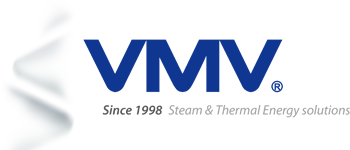In steam systems used for heating, temperature control, refrigeration, and even industrial fluid automation, pressure reducing valves are a common and indispensable fluid control component. Their main function is to reduce high-pressure steam to the low-pressure steam required by the equipment, ensuring the equipment operates at its most efficient level. This valve does not require any external power or controller; it relies primarily on its own steam medium as power to automatically regulate and stabilize the pressure downstream of the valve. Let’s explore the world of pressure reducing valves together.
Working Principle of Pressure Reducing Valves
The working principle of pressure reducing valves is mainly based on the throttling principle in fluid mechanics. By changing the throttling area, the flow velocity and kinetic energy of the fluid are altered, resulting in different pressure losses and achieving pressure reduction. Simultaneously, the control and regulation system balances the fluctuations in downstream pressure with the spring force (or other regulating force), thus maintaining a constant downstream pressure within a certain error range. The following details the working principle of different types of pressure reducing valves:
Piston-type Pressure Reducing Valve
The core component is the piston, belonging to the pilot-operated type of pressure reducing valve. This valve achieves pressure reduction and stabilization through the linkage of a main valve and a pilot valve. The main valve includes a valve seat, piston, and spring, while the pilot valve consists of a valve disc, diaphragm, and adjusting spring. The diaphragm senses pressure changes and drives the piston to adjust the throttling area of the main valve, maintaining a dynamic balance of the outlet pressure. It balances pressure through the piston, driving the valve disc movement; however, due to the greater friction of the piston within the cylinder, its sensitivity is lower than that of a diaphragm-type pressure reducing valve.
Differential pressure reducing valve
During operation, reduces high-pressure oil through the valve core throttling orifice, resulting in low-pressure oil output. The outlet pressure is transmitted to the upper chamber through the axial hole of the valve core, causing the pressure difference between the inlet and outlet to act on the effective area of the valve core and maintain dynamic balance with the spring force. By reducing the spring stiffness and decreasing the valve opening, the pressure difference can be approximately maintained at the set value, meaning the pressure difference between the inlet and outlet is equal to or approximately constant.
Hydraulic pressure reducing valve
The hydraulic pressure reducing valve (a type of piston-type pressure reducing valve) has a core structure including a cast-in-one valve body, a three-layer porous cage, and a piston rod assembly. The axially symmetrical flow channel reduces turbulence and noise. The valve body uses a 90°angle transmission mechanism to drive the piston, and a patented sealing system to achieve airtight closure. The pressure balance design ensures that the piston movement is not affected by pressure difference, and the regulation characteristics are linear, with the minimum flow rate located at 10% opening. The pneumatic actuator converts the electrical signal into a pressure signal to precisely control the opening, which can stably reduce the dynamic and static pressure of the fluid, and maintain positive pressure operation in the pipeline by throttling the potential energy.
Features of Pressure Reducing Valves
Advantages
Precise Pressure Stabilization: Continuously reduces the high pressure at the inlet to the constant pressure required downstream, and automatically maintains a relatively constant outlet pressure even when the inlet pressure or flow rate fluctuates.
High Adaptability: The required pressure can be quickly set by rotating the handwheel or adjusting screw to meet the needs of different operating conditions.
Downstream Protection: Prevents damage to equipment due to excessive pressure, extending the service life of valves, pipelines, and instruments.
Wide Application: Suitable for various media such as water, steam, air, oil, and liquefied gas; corresponding models are available for industrial, building, fire protection, and gas appliance applications.
Self-Balancing Structure: Relies on the energy of the medium itself for automatic adjustment, requiring no external power and ensuring reliable operation.
Disadvantages
Energy Loss: Pressure loss is inevitable during the throttling process, and some energy is dissipated as heat. Additional pressurization may be required for long-distance transmission.
Failure Risks: Seals such as diaphragms and O-rings are prone to aging and wear, leading to leakage; impurities can easily clog the throttling orifice or valve core, causing adjustment failure.
Environmental Sensitivity: Under high temperature, vibration, or frequent and significant changes in operating conditions, the setpoint may drift, affecting pressure regulation accuracy.
Cost and Maintenance: High-precision or corrosion-resistant models are expensive; regular inspection, cleaning, and replacement of vulnerable parts are required, and maintenance costs increase with the number of installations.

Conventional pressure reducing valves are prone to poor adjustment accuracy, large pressure fluctuations after pressure reduction, short valve life, and large leakage. In severe cases, it can lead to overpressure and emergency shutdown, causing significant losses to users. To address these potential problems, the Newton R&D team conducted in-depth on-site investigations, collected extensive operating condition information, and tackled technical challenges. Through extensive testing, they verified that the designed, manufactured, and mass-produced V5001 series pilot-operated steam pressure reducing valves fully meet user needs. The V5001 series pilot-operated steam pressure reducing valves have the following characteristics:
- High pressure reduction accuracy, up to ±3%;
- Wide pressure adjustment range, 0.02-2MPa;
- High pressure reduction ratio, up to 20:1;
- Good control stability; Long service life;
- High temperature and pressure resistance;
- Large flow capacity; Fast response speed;
- Enables long-term maintenance-free online operation.
Please contact us if needed; Newton is always at your service.

